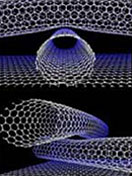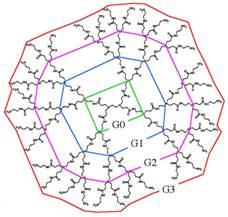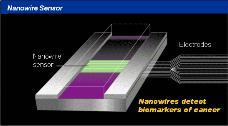











 |
 |
 |
 |
 |
 |
 |
 |
 |
 |
 |
 |
 |
 |
 |
 |
 |
 |
 |
 |
 |
 |
 |
 |
 |
 |
 |
 |
 |


1. Nanotechnology
Importance of Nanotechnology
Work is currently being done to find ways to safely move these new research tools into clinical practice. But there are already examples in clinical use that show the promise of nanotechnology.
Nanotechnology has been used to create new and improved imaging techniques to find small tumors. Researchers have shown that incredibly small iron oxide particles (nanoparticulates) can be used with magnetic resonance imaging (MRI) to accurately detect cancers that have spread to lymph nodes, without requiring surgery.
Nanoscale drug delivery devices are being developed to deliver anticancer therapeutics specifically to tumors. Liposomes are one such “first generation” nanoscale device. Liposomal doxorubicin is used to treat specific forms of cancer, while liposomal amphotericin B treats fungal infections often associated with aggressive anticancer treatment. Recently, a nanoparticulate formulation of the well-known anticancer compound taxol was submitted as a new treatment for advanced stage breast cancer.
In the near future, nanoscale devices may lead to detection of the earliest stages of cancer while simultaneously delivering anticancer agents to the tumor. Early research has shown that nanoparticulate sensors can detect the cell death that occurs when a cancer cell succumbs to the effects of an anticancer drug. As a highly sensitive means of determining if a therapy is working, this application of nanotechnology could save a patient from months of ineffective medication and debilitating side effects, allowing a switch to a potentially more effective course of treatment. In addition, such a sensor could greatly accelerate clinical trials of new anticancer agents, again by demonstrating very early signals of the effectiveness of a drug.
Over the next five years that nanotechnology will result in significant advances in early detection, molecular imaging, assessment of therapeutic efficacy, targeted and multifunctional therapeutics, and the prevention and control of cancer.
Potential of Nanotechnology
Nanoscale devices are somewhere from one hundred to ten thousand times smaller than human cells. They are similar in size to large biological molecules (“biomolecules”) such as enzymes and receptors. As an example, hemoglobin, the molecule that carries oxygen in red blood cells, is approximately 5 nanometers in diameter. Nanoscale devices smaller than 50 nanometers can easily enter most cells, while those smaller than 20 nanometers can move out of blood vessels as they circulate through the body.
Because of their small size, nanoscale devices can readily interact with biomolecules on both the surface of cells and inside of cells. By gaining access to so many areas of the body, they have the potential to detect disease and deliver treatment in ways unimagined before now. Since biological processes—including events that lead to cancer—occur at the nanoscale at and inside cells, nanotechnology offers a wealth of tools that are providing cancer researchers with new and innovative ways to diagnose and treat cancer.
Buckyball or Fullerene or C60
One of three known pure forms of carbon (graphite and diamond being the other two) that takes a spherical shape with a hollow interior. Buckyballs, named because they resemble the geodesic domes built by architect Buckminster Fuller, were discovered in 1985 among the byproducts of laser vaporization of graphite in which the carbon atoms are arranged in sheets. Though C60, referring to the number of carbon atoms that make up one sphere, is the most common fullerene, researchers have found stable, spherical carbon structures containing 70 atoms (C70), 120 (C120), 180 (C180), and others.
Robert F. Curl Jr. and Richard E. Smalley, both of Rice University in Houston, Texas and Harold W. Kroto of the University of Sussex in England, won the 1996 Nobel Prize for Chemistry for their discovery of buckminsterfullerene, the scientific name for buckyballs.
Carbon Nanotubes
 A form of carbon related to fullerenes, except that the carbon atoms form extended hollow tubes instead of closed, hollow spheres. Carbon nanotubes can also form as a series of nested, concentric tubes. Carbon nanotubes can be used as nanometer-scale syringe needles for injecting molecules into cells and as nanoscale probes for making fine-scale measurements. Carbon nanotubes can be filled and capped, forming nanoscale test tubes or potential drug delivery devices. Carbon nanotubes can also be “doped,” or modified with small amounts of other elements, giving them electrical properties that include fully insulating, semiconducting, and fully conducting.
A form of carbon related to fullerenes, except that the carbon atoms form extended hollow tubes instead of closed, hollow spheres. Carbon nanotubes can also form as a series of nested, concentric tubes. Carbon nanotubes can be used as nanometer-scale syringe needles for injecting molecules into cells and as nanoscale probes for making fine-scale measurements. Carbon nanotubes can be filled and capped, forming nanoscale test tubes or potential drug delivery devices. Carbon nanotubes can also be “doped,” or modified with small amounts of other elements, giving them electrical properties that include fully insulating, semiconducting, and fully conducting.
 Dendrimer
Dendrimer
A dendrimer is a spherical, highly branched polymer molecule. Dendrimers are made from two different monomers – a reactive amine and an acrylic acid – and are assembled in discrete steps, which allow them to be constructed with an exact size that depends on the number of enlargement steps. This picture shows a dendrimer that has undergone three “generations” of enlargements.
Dendrimers are of particular interest for cancer applications because of their defined and reproducible size, but more importantly, because it is easy to add a variety of other molecules to the surface of a dendrimer. Such molecules could include tumor-targeting agents (including but not restricted to monoclonal antibodies), imaging contrast agents to pinpoint tumors, drug molecules for delivery to a tumor, and reporter molecules that might detect if an anticancer drug is working.
Imaging Contrast Agent
A molecule or molecular complex that increases the intensity of the signal detected by an imaging technique, including MRI and ultrasound. An MRI contrast agent, for example, might contain gadolinium attached to a targeting antibody. The antibody would bind to a specific target – a metastatic melanoma cell, for example – while the gadolinium would increase the magnetic signal detected by the MRI scanner.
Liposome
A type of nanoparticle made of lipids, or fat molecules, surrounding a water core. Liposomes, several of which are widely used to treat infectious diseases and cancer, were the first type of nanoparticle to be used to create therapeutic agents with novel characteristics.
Microfluidics
A multidisciplinary field comprising physics, chemistry, engineering and biotechnology that studies the behavior of fluids at volumes thousands of times smaller than a common droplet. Microfluidic components form the basis of so-called “lab-on-a-chip” devices that can process microliter and nanoliter volumes and conduct highly sensitive analytical measurements. The fabrications techniques used to construct microfluidic devices are relatively inexpensive and are amenable both to highly elaborate, multiplexed devices and also to mass production. In a manner similar to that for microelectronics, microfluidic technologies enable the fabrication of highly integrated devices for performing several different functions on the same substrate chip. Microfluidics is a critical component in gene chip and protein chip development efforts.
Nanocantilever
The simplest micro-electro-mechanical system (MEMS) that can be easily machined and mass-produced via the same techniques used to make computer chips. The ability to detect extremely small displacements make nanocantilever beams an ideal device for detecting extremely small forces, stresses and masses. Nanocantilevers coated with antibodies, for example, will bend from the mass added when substrate binds to its antibody, providing a detector capable of sensing the presence of single molecules of clinical importance.
Nanometer
A unit of spatial measurement that equals one-billionth (10 -9) of a meter. The head of a pin is about 1 million nanometers across. A human hair is about 60,000 nanometers in diameter, while a DNA molecule is between 2-12 nanometers wide.
 Nanoparticle
Nanoparticle
A nanoscale spherical or capsule-shaped structure. Most, though not all, nanoparticles are hollow, which provides a central reservoir that can be filled with anticancer drugs, detection agents, or chemicals, known as reporters, that can signal if a drug is having a therapeutic effect. The surface of a nanoparticle can also be adorned with various targeting agents, such as antibodies, drugs, imaging agents, and reporters. Most nanoparticles are constructed to be small enough to pass through blood capillaries and enter cells.
 Nanoshell
Nanoshell
A nanoparticle composed of a metallic shell surrounding a semiconductor. When nanoshells reach a target cancer cell, they can be irradiated with near-infrared light or excited with a magnetic field, either of which will cause the nanoshell to become hot, killing the cancer cell.
Nanotechnology
 The interactions of cellular and molecular components and engineered materials—typically clusters of atoms, molecules, and molecular fragments—at the most elemental level of biology. Such nanoscale objects—typically, though not exclusively, with dimensions smaller than 100 nanometers—can be useful by themselves or as part of larger devices containing multiple nanoscale objects.
The interactions of cellular and molecular components and engineered materials—typically clusters of atoms, molecules, and molecular fragments—at the most elemental level of biology. Such nanoscale objects—typically, though not exclusively, with dimensions smaller than 100 nanometers—can be useful by themselves or as part of larger devices containing multiple nanoscale objects.
 Nanowire
Nanowire
A nanometer-scale wire made of metal atoms, silicon, or other materials that conduct electricity. Nanowires are built atom by atom on a solid surface, often as part of a microfluidic device. They can be coated with molecules such as antibodies that will bind to proteins and other substances of interest to researchers and clinicians. By the very nature of their nanoscale size, nanowires are incredibly sensitive to such binding events and respond by altering the electrical current flowing through them, and thus can form the basis of ultra sensitive molecular detectors.
 Quantum dot (Qdots)
Quantum dot (Qdots)
Nanometer sized semiconductor particles, made of cadmium selenide (CdSe), cadmium sulfide (CdS) or cadmium telluride (CdTe) with an inert polymer coating. The semiconductor material used for the core is chosen based upon the emission wavelength range being targeted: CdS for UV-blue, CdSe for the bulk of the visible spectrum, CdTe for the far red and near-infrared, with the particle’s size determining the exact color of a given quantum dot. The polymer coating safeguards cells from cadmium toxicity but also affords the opportunity to attach any variety targeting molecules, including monoclonal antibodies directed to tumor-specific biomarkers. Because of their small size, quantum dots can function as cell- and even molecule-specific markers that will not interfere with the normal workings of a cell. In addition, the availability of quantum dots of different colors provides a powerful tool for following the actions of multiple cells and molecules simultaneously.
In August 2004, researchers announced the successful preparation of water-soluble gold quantum dots that can also be constructed to emit light at a variety of wavelengths. These polymer-coated quantum dots may prove to be more suitable for use in human clinical applications.
Goals of Research
- Research tools to identify new biological targets
- Agents to prevent precancerous cells from becoming malignant
- Imaging agents and diagnostics to detect cancer in the pre-symptomatic stage
- Multi-functional targeted devices to deliver therapeutic agents directly to cancer cells
- Systems to provide real-time assessments of therapeutic and surgical efficacy
- Novel methods to manage symptoms that reduce quality of life
2. Claytronics

















